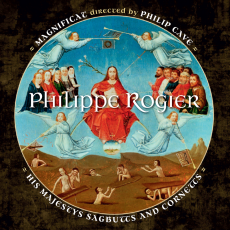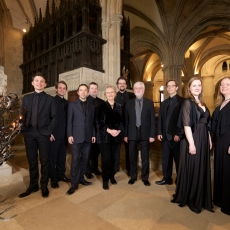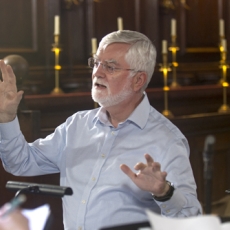Magnificat - Polychoral Works - The Consort
The magnificence of the Spanish Golden Age is the outstanding aspect of this recording, which features the work of a neglected but highly-accomplished Flemish composer, Philippe Rogier (c1561-96). He was employed at the court of Philip II of Spain at a time when the musical world was moving from the weaving lines of renaissance polyphony to the more homophonic, rhythmic, polychoral antiphony of the baroque, with its basso continuo accompaniment. Philip Cave reminds us that, during this late 16th-century time of experiment, the performer had an important role in bringing the notation on the page to life.
Here, in keeping with the exploratory nature of the emerging baroque, Cave takes Rogier's music and 'reinvents' it by adding instruments and ornamental flourishes to the written vocal parts. The sound that he achieves is rich and vibrant, the perfect intonation of the notoriously difficult cornetts blending with the well-balanced voices of the choir. Magnificat, a group of seventeen singers is accompanied by His Majesty's Sagbutts and Cornetts. Cornetts and mute cornetts are played by Jeremy West and Jamie Savan; sagbutts by Emily white, Susan Addison and Wim Becu. Additional instrumentalists are Joy Smith (harp), David Miller (lute), Keith McGowan (dulcian) and Silas Standage (organ).
Two polychoral Masses are central to the programme - Rogier's twelve-voice Missa Domine Dominus Noster and his eight-voice Missa Domine in virtute tua; they are interspersed with motets. First to be heard is the motet Domine Dominus Noster, which has been transcribed and edited from a manuscript in Valladolid Cathedral, MS 70/331; it is recorded here for the first time. The Missa Domine Dominus Noster which follows is musically unrelated to the motet, despite the similarity of their names. In this Mass, the twelve voices are split into three four-part choirs, each having its own organ continuo lines - a basso seguente. the whole is underpinned by a Guion (or leader), a complete bass line being formed by the other three continuo lines. Typically, Rogier begins quietly with choir 1 then builds up the vocal texture, moving through a section of homophonic antiphony to a resounding finale employing all three choirs.
This Mass, an expanded version of the popular, two-choir Missa Domine Dominus Noster, might have been written around 1590, after the installation of three organs in Philip II's new royal establishment, El Escorial. The founding statutes of El Escorial forbade the use of polyphonic music and of instruments, and as a priest and employee of Philip II, Rogier would surely have obeyed these statutes. However, the scoring of this Mass for a cappella voices supported by continuo indicates that organ accompaniment was allowed.
Cave justifies the addition of other instruments by referring to evidence concerning their use on major feast days such as Corpus Christi or the patronal festival of St Lawrence. He provides further justification by attributing to the word Dominus the double meaning of 'a temporal or spiritual Lord'. With the sound of brass, he captures the majestic image of royalty; although arguably some of Rogier's more subtle vocal scoring in the reflective sections of the Mass sometimes loses impact.
Two eight-voice motets follow; both originally scored a cappella for two four-part choirs with no basso continuo; instrumentation has been added to both. Regina caeli, based on the well-known plainsong melody of that name, begins quietly with choir 1 and builds up through a central, homophonic, antiphonal section to a grand tutti finale. Laudate Dominum (psalm 150) likewise builds to a climax, while illustrating the instruments of the text appropriately.
Palestrina's motet, the eight-part Domine in virtute tua, is the only work performed a cappella without continuo on this recording. Such a polished performance by this well-blended group of voices makes very pleasurable listening. Rogier's Missa Domine in virtute tua, based on Palestrina's motet, follows. Originally scored for eight unaccompanied voices, Cave has added a basso continuo of organ and dulcian: although this is arguably an 'authentic' baroque modification, the additional weight of the continuo bass does not really work for this reviewer.
The programme concludes with two magnificent Christmas motets, Videntes stellam magi and Verbum caro factum est. Laverne Wagner, citing Leichtentritt, describes the latter as an early example of the use of continuo which was to become common practice in the early baroque period. The voices are divided into three four-part choirs, each with its own continuo line. An interesting variant is that while Rogier specifies organ continuo for choirs 2 and 3, he scores choir 1 for high voices accompanied by a harp, evoking, perhaps, the presence of angels and the quiet, mysterious, reflective awe of the Incarnation.
Mystery rather than majesty is possibly what Rogier had in mind, for choir 1 plays a leading role, being given the opening section and two intervening episodes/verses. The tranquility of such passages is sometimes overwhelmed by the embellished, brassy splendour of His Majesty's Sagbutts and Cornetts, but this is a question of preference and taste. This recording is worth hearing on account of its imaginative and thoughtful interpretation of a neglected but highly competent composer of late renaissance.


